高中英语语法试讲教案.doc
- 格式:doc
- 大小:22.71 KB
- 文档页数:9
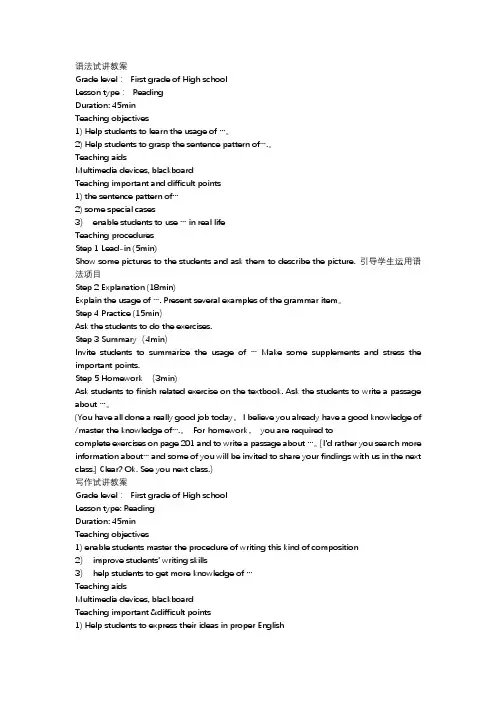
语法试讲教案Grade level:First grade of High schoolLesson type:ReadingDuration: 45minTeaching objectives1) Help students to learn the usage of …。
2) Help students to grasp the sentence pattern of….。
Teaching aidsMultimedia devices, blackboardTeaching important and difficult points1) the sentence pattern of…2) some special cases3)enable students to use … in real lifeTeaching proceduresStep 1 Lead-in (5min)Show some pictures to the students and ask them to describe the picture. 引导学生运用语法项目Step 2 Explanation (18min)Explain the usage of …. Present several examples of the grammar item。
Step 4 Practice (15min)Ask the students to do the exercises.Step 3 Summary(4min)Invite students to summarize the usage of … Make some supplements and stress the important points.Step 5 Homework (3min)Ask students to finish related exercise on the textbook. Ask the students to write a passage about …。
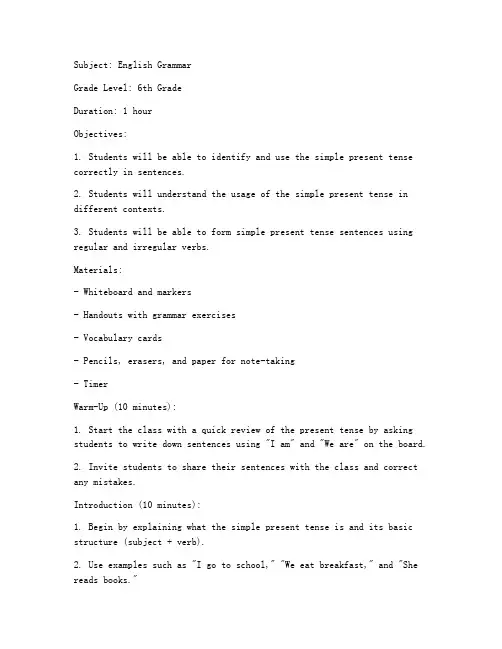
Subject: English GrammarGrade Level: 6th GradeDuration: 1 hourObjectives:1. Students will be able to identify and use the simple present tense correctly in sentences.2. Students will understand the usage of the simple present tense in different contexts.3. Students will be able to form simple present tense sentences using regular and irregular verbs.Materials:- Whiteboard and markers- Handouts with grammar exercises- Vocabulary cards- Pencils, erasers, and paper for note-taking- TimerWarm-Up (10 minutes):1. Start the class with a quick review of the present tense by asking students to write down sentences using "I am" and "We are" on the board.2. Invite students to share their sentences with the class and correct any mistakes.Introduction (10 minutes):1. Begin by explaining what the simple present tense is and its basic structure (subject + verb).2. Use examples such as "I go to school," "We eat breakfast," and "She reads books."3. Point out that the simple present tense is used to describe habits, general truths, and unchanging situations.Vocabulary and Usage (15 minutes):1. Introduce vocabulary related to the simple present tense, such as "always," "often," "sometimes," "never," and "usually."2. Use these adverbs to form sentences with the simple present tense,e.g., "I always do my homework," "We usually have English class on Monday."3. Discuss the difference between "always" and "often," emphasizing that "always" is used for regular, consistent actions, while "often"indicates frequency but not necessarily regularity.Grammar Exercises (20 minutes):1. Distribute handouts with a variety of exercises to practice forming simple present tense sentences.2. Exercises may include:- Fill in the blanks with the correct form of the verb.- Choose the correct verb form to complete the sentence.- Write sentences using the simple present tense with given vocabulary words.3. Circulate around the classroom to assist students and correct any mistakes.Interactive Activity (10 minutes):1. Divide the class into small groups.2. Each group is given a scenario, such as "A family is planning a vacation" or "A student is describing their favorite hobbies."3. Students must use the simple present tense to create a short dialogue or story based on their scenario.Review and Practice (10 minutes):1. Go over the key points of the lesson, emphasizing the rules for forming simple present tense sentences with regular and irregular verbs.2. Have students practice forming sentences with new vocabulary words from the handouts.Homework Assignment:1. Assign a short writing exercise where students describe their daily routine using the simple present tense.2. Encourage them to use at least three different adverbs of frequency.Conclusion:1. Summarize the main points of the lesson and reinforce the importance of using the simple present tense accurately.2. Open the floor for any questions or clarifications from students.3. Thank the students for their participation and encourage them to practice the simple present tense in their daily language use.Assessment:- Monitor students' participation in class activities and exercises.- Evaluate the quality of their homework assignments.- Conduct a short quiz at the end of the lesson to assess their understanding of the simple present tense.。
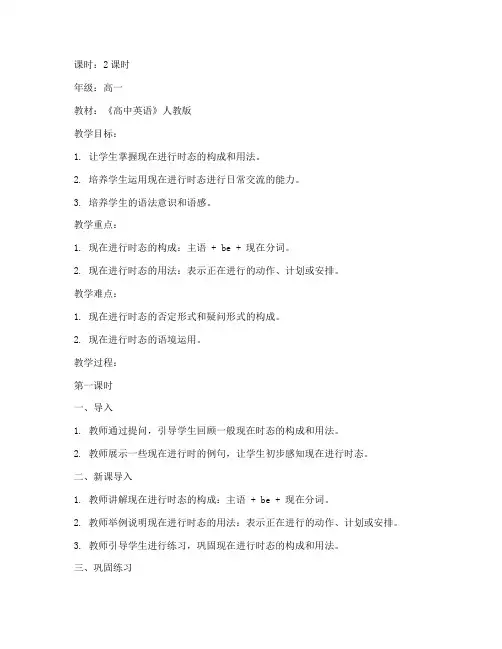
课时:2课时年级:高一教材:《高中英语》人教版教学目标:1. 让学生掌握现在进行时态的构成和用法。
2. 培养学生运用现在进行时态进行日常交流的能力。
3. 培养学生的语法意识和语感。
教学重点:1. 现在进行时态的构成:主语 + be + 现在分词。
2. 现在进行时态的用法:表示正在进行的动作、计划或安排。
教学难点:1. 现在进行时态的否定形式和疑问形式的构成。
2. 现在进行时态的语境运用。
教学过程:第一课时一、导入1. 教师通过提问,引导学生回顾一般现在时态的构成和用法。
2. 教师展示一些现在进行时的例句,让学生初步感知现在进行时态。
二、新课导入1. 教师讲解现在进行时态的构成:主语 + be + 现在分词。
2. 教师举例说明现在进行时态的用法:表示正在进行的动作、计划或安排。
3. 教师引导学生进行练习,巩固现在进行时态的构成和用法。
三、巩固练习1. 教师给出一些句子,让学生判断句子中的时态。
2. 教师给出一些句子,让学生将一般现在时态改为现在进行时态。
3. 教师给出一些句子,让学生将现在进行时态改为一般现在时态。
四、课堂小结1. 教师总结现在进行时态的构成和用法。
2. 学生分享学习心得。
第二课时一、复习1. 教师提问,检查学生对现在进行时态的掌握情况。
2. 学生回答问题,教师点评。
二、新课导入1. 教师讲解现在进行时态的否定形式和疑问形式的构成。
2. 教师举例说明现在进行时态的否定形式和疑问形式的用法。
三、巩固练习1. 教师给出一些句子,让学生判断句子中的时态。
2. 教师给出一些句子,让学生将一般现在时态改为现在进行时态的否定形式或疑问形式。
3. 教师给出一些句子,让学生将现在进行时态改为一般现在时态的否定形式或疑问形式。
四、课堂小结1. 教师总结现在进行时态的构成、用法、否定形式和疑问形式的构成。
2. 学生分享学习心得。
教学反思:1. 教师在教学过程中,注重引导学生进行实践,提高学生的语法意识和语感。
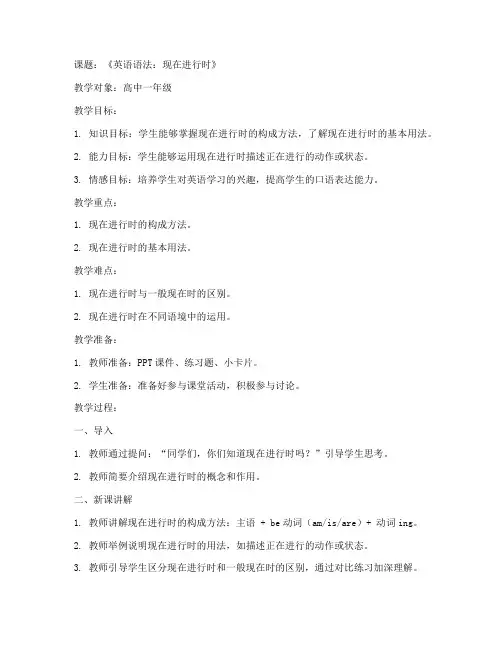
课题:《英语语法:现在进行时》教学对象:高中一年级教学目标:1. 知识目标:学生能够掌握现在进行时的构成方法,了解现在进行时的基本用法。
2. 能力目标:学生能够运用现在进行时描述正在进行的动作或状态。
3. 情感目标:培养学生对英语学习的兴趣,提高学生的口语表达能力。
教学重点:1. 现在进行时的构成方法。
2. 现在进行时的基本用法。
教学难点:1. 现在进行时与一般现在时的区别。
2. 现在进行时在不同语境中的运用。
教学准备:1. 教师准备:PPT课件、练习题、小卡片。
2. 学生准备:准备好参与课堂活动,积极参与讨论。
教学过程:一、导入1. 教师通过提问:“同学们,你们知道现在进行时吗?”引导学生思考。
2. 教师简要介绍现在进行时的概念和作用。
二、新课讲解1. 教师讲解现在进行时的构成方法:主语 + be动词(am/is/are)+ 动词ing。
2. 教师举例说明现在进行时的用法,如描述正在进行的动作或状态。
3. 教师引导学生区分现在进行时和一般现在时的区别,通过对比练习加深理解。
三、课堂活动1. 教师通过PPT展示一些图片,让学生用现在进行时描述图片中的场景。
2. 学生两人一组,用现在进行时进行角色扮演,模拟对话。
3. 教师请学生上台表演,其他学生进行评价。
四、巩固练习1. 教师发放练习题,让学生在规定时间内完成。
2. 教师讲解练习题的正确答案,并对学生的答案进行点评。
五、总结1. 教师对本节课的内容进行总结,强调现在进行时的构成方法和用法。
2. 教师鼓励学生在日常生活中多运用现在进行时,提高口语表达能力。
教学反思:本节课通过多种教学方法和活动,帮助学生掌握了现在进行时的构成方法和用法。
在教学过程中,要注意以下几点:1. 注重学生的参与度,鼓励学生积极参与课堂活动。
2. 在讲解过程中,注意结合实际生活,让学生感受到英语学习的实用性。
3. 在练习环节,要关注学生的错误,及时进行纠正和指导。
4. 教师要根据学生的实际情况,适时调整教学进度和难度。
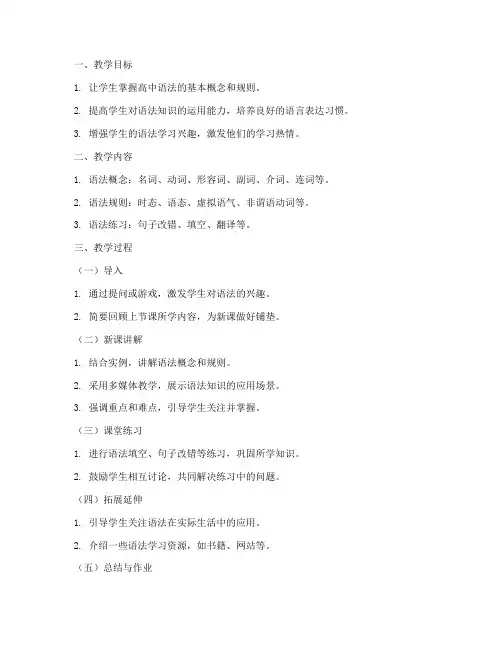
一、教学目标1. 让学生掌握高中语法的基本概念和规则。
2. 提高学生对语法知识的运用能力,培养良好的语言表达习惯。
3. 增强学生的语法学习兴趣,激发他们的学习热情。
二、教学内容1. 语法概念:名词、动词、形容词、副词、介词、连词等。
2. 语法规则:时态、语态、虚拟语气、非谓语动词等。
3. 语法练习:句子改错、填空、翻译等。
三、教学过程(一)导入1. 通过提问或游戏,激发学生对语法的兴趣。
2. 简要回顾上节课所学内容,为新课做好铺垫。
(二)新课讲解1. 结合实例,讲解语法概念和规则。
2. 采用多媒体教学,展示语法知识的应用场景。
3. 强调重点和难点,引导学生关注并掌握。
(三)课堂练习1. 进行语法填空、句子改错等练习,巩固所学知识。
2. 鼓励学生相互讨论,共同解决练习中的问题。
(四)拓展延伸1. 引导学生关注语法在实际生活中的应用。
2. 介绍一些语法学习资源,如书籍、网站等。
(五)总结与作业1. 总结本节课所学内容,强调重点和难点。
2. 布置适量作业,巩固所学知识。
四、教学评价1. 观察学生在课堂上的参与度,了解他们对语法知识的掌握情况。
2. 收集学生的作业,检查他们对语法知识的运用能力。
五、教学时间1. 总体时间:1课时2. 具体安排:- 导入:5分钟- 新课讲解:20分钟- 课堂练习:15分钟- 拓展延伸:5分钟- 总结与作业:5分钟六、教学资源1. 教材:人教版高中英语教材2. 多媒体课件:语法知识讲解、练习题等3. 语法学习资源:书籍、网站等七、教学注意事项1. 注重启发式教学,引导学生主动学习。
2. 营造轻松愉快的课堂氛围,激发学生的学习兴趣。
3. 针对学生的个体差异,实施分层教学。
4. 关注学生的学习效果,及时调整教学策略。
本教案旨在帮助学生掌握高中语法知识,提高他们的语言表达能力。
在教学过程中,教师应根据学生的实际情况,灵活调整教学内容和方法,以确保教学效果。
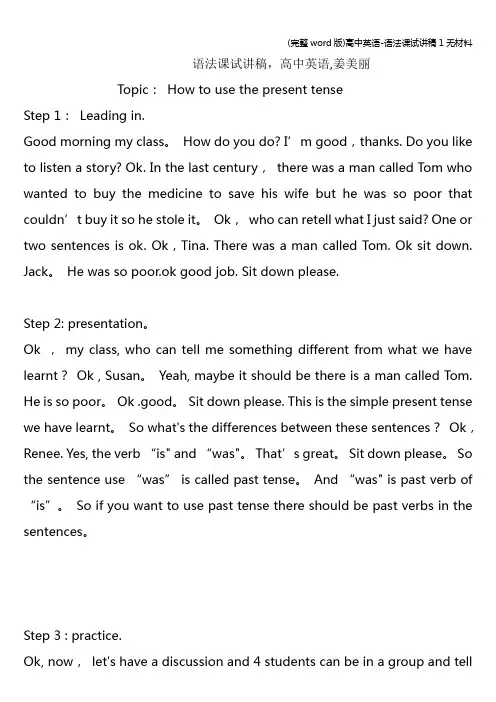
语法课试讲稿,高中英语,姜美丽Topic:How to use the present tenseStep 1:Leading in.Good morning my class。
How do you do? I’m good,thanks. Do you like to listen a story? Ok. In the last century,there was a man called Tom who wanted to buy the medicine to save his wife but he was so poor that couldn’t buy it so he stole it。
Ok,who can retell what I just said? One or two sentences is ok. Ok,Tina. There was a man called Tom. Ok sit down. Jack。
He was so poor.ok good job. Sit down please.Step 2: presentation。
Ok ,my class, who can tell me something different from what we have learnt?Ok , Susan。
Yeah, maybe it should be there is a man called Tom. He is so poor。
Ok .good。
Sit down please. This is the simple present tense we have learnt。
So what's the differences between these sentences?Ok,Renee. Yes, the verb “is" and “was"。
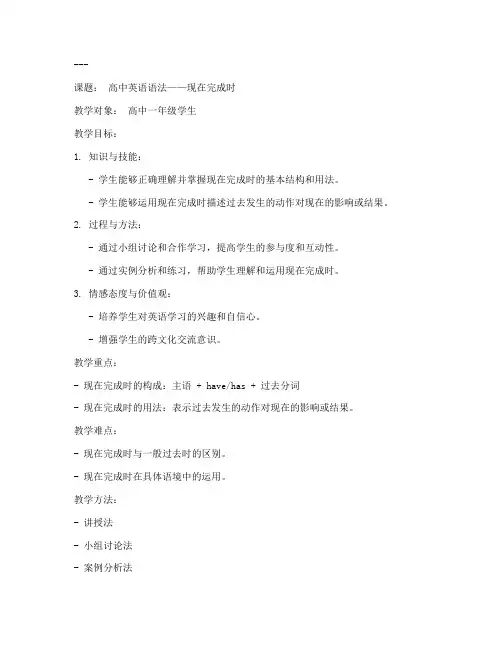
---课题:高中英语语法——现在完成时教学对象:高中一年级学生教学目标:1. 知识与技能:- 学生能够正确理解并掌握现在完成时的基本结构和用法。
- 学生能够运用现在完成时描述过去发生的动作对现在的影响或结果。
2. 过程与方法:- 通过小组讨论和合作学习,提高学生的参与度和互动性。
- 通过实例分析和练习,帮助学生理解和运用现在完成时。
3. 情感态度与价值观:- 培养学生对英语学习的兴趣和自信心。
- 增强学生的跨文化交流意识。
教学重点:- 现在完成时的构成:主语 + have/has + 过去分词- 现在完成时的用法:表示过去发生的动作对现在的影响或结果。
教学难点:- 现在完成时与一般过去时的区别。
- 现在完成时在具体语境中的运用。
教学方法:- 讲授法- 小组讨论法- 案例分析法- 练习法教学过程:一、导入- 通过提问:“你能用英语描述一下你今天早上做了什么吗?”引导学生进入今天的学习主题。
二、新课讲解1. 讲解现在完成时的构成:- 展示例句,让学生观察并总结现在完成时的构成。
- 强调“have/has”与过去分词的搭配。
2. 讲解现在完成时的用法:- 通过图片或情景展示,讲解现在完成时在描述过去动作对现在影响时的用法。
- 举例说明现在完成时与一般过去时的区别。
三、小组讨论- 将学生分成小组,讨论以下问题:- 现在完成时和一般过去时在语境中的区别。
- 如何正确使用现在完成时。
四、案例分析- 提供一段对话或短文,让学生找出并分析其中的现在完成时用法。
五、练习- 进行现在完成时的填空练习,巩固所学知识。
六、总结- 回顾今天所学内容,强调现在完成时的构成和用法。
- 提醒学生在日常生活中注意现在完成时的运用。
七、作业布置- 完成课后练习题,复习今天所学内容。
教学反思:本节课通过多种教学方法,帮助学生理解和掌握现在完成时的语法知识。
在教学过程中,要注意观察学生的反应,适时调整教学节奏和方法。
同时,鼓励学生积极参与课堂活动,提高他们的学习兴趣和主动性。
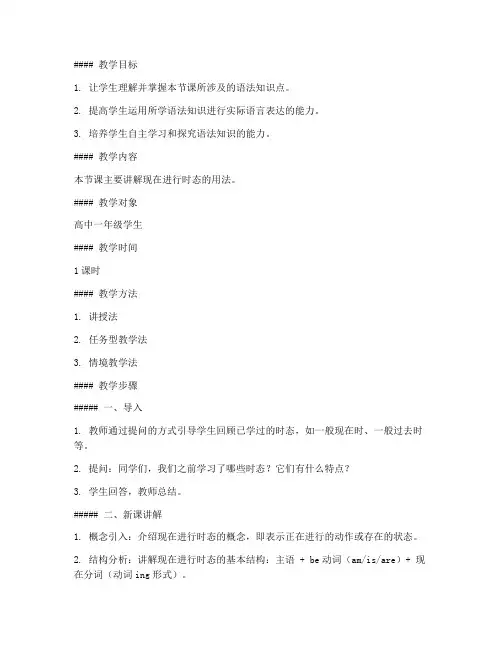
#### 教学目标1. 让学生理解并掌握本节课所涉及的语法知识点。
2. 提高学生运用所学语法知识进行实际语言表达的能力。
3. 培养学生自主学习和探究语法知识的能力。
#### 教学内容本节课主要讲解现在进行时态的用法。
#### 教学对象高中一年级学生#### 教学时间1课时#### 教学方法1. 讲授法2. 任务型教学法3. 情境教学法#### 教学步骤##### 一、导入1. 教师通过提问的方式引导学生回顾已学过的时态,如一般现在时、一般过去时等。
2. 提问:同学们,我们之前学习了哪些时态?它们有什么特点?3. 学生回答,教师总结。
##### 二、新课讲解1. 概念引入:介绍现在进行时态的概念,即表示正在进行的动作或存在的状态。
2. 结构分析:讲解现在进行时态的基本结构:主语 + be动词(am/is/are)+ 现在分词(动词ing形式)。
3. 举例说明:展示多个例句,让学生理解现在进行时态的用法。
- 例句1:I am reading a book.- 例句2:She is watching TV.- 例句3:They are playing football.4. 注意事项:讲解现在进行时态的常见错误和注意事项,如be动词的人称和数的变化、现在分词的构成等。
##### 三、任务型教学1. 小组活动:将学生分成小组,要求每个小组用现在进行时态造句,并相互检查。
2. 角色扮演:请学生扮演不同的角色,用现在进行时态进行对话练习。
##### 四、巩固练习1. 填空练习:教师给出句子,让学生填入正确的现在进行时态。
2. 翻译练习:将中文句子翻译成英文,要求使用现在进行时态。
##### 五、总结1. 教师总结本节课所学内容,强调现在进行时态的用法和注意事项。
2. 学生回顾所学知识,提出疑问。
##### 六、作业布置1. 完成课后练习题。
2. 用现在进行时态写一篇短文。
#### 教学反思1. 教师在教学过程中应关注学生的参与度和学习效果,及时调整教学策略。
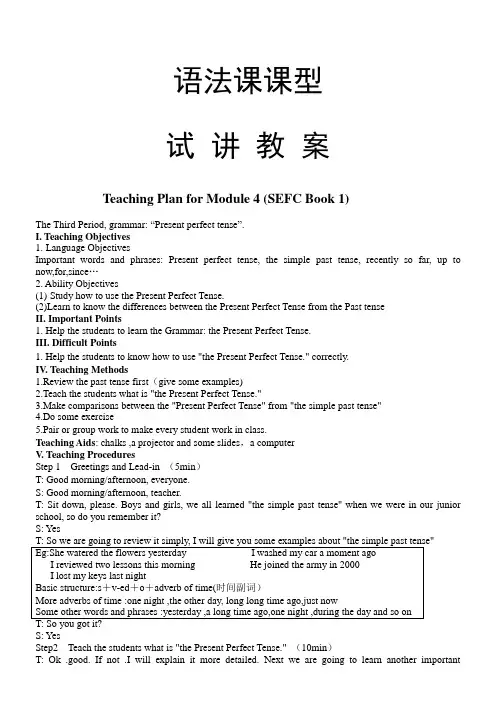
语法课课型试讲教案Teaching Plan for Module 4 (SEFC Book 1)The Third Period, grammar:“Present perfect tense”.I. Teaching Objectivesnguage ObjectivesImportant words and phrases: Present perfect tense, the simple past tense, recently so far, up to now,for,since…2. Ability Objectives(1)Study how to use the Present Perfect Tense.(2)Learn to know the differences between the Present Perfect Tense from the Past tenseII. Important Points1. Help the students to learn the Grammar: the Present Perfect Tense.III. Difficult Points1. Help the students to know how to use "the Present Perfect Tense." correctly.IV. Teaching Methods1.Review the past tense first(give some examples)2.Teach the students what is "the Present Perfect Tense."3.Make comparisons between the "Present Perfect Tense" from "the simple past tense"4.Do some exercise5.Pair or group work to make every student work in class.Teaching Aids: chalks ,a projector and some slides,a computerV. Teaching ProceduresStep 1 Greetings and Lead-in (5min)T: Good morning/afternoon, everyone.S: Good morning/afternoon, teacher.T: Sit down, please. Boys and girls, we all learned "the simple past tense" when we were in our junior school, so do you remember it?S: YesT: So we are going to review it simply, I will give you some examples about "the simple past tense" Eg:She watered the flowers yesterday I washed my car a moment agoI reviewed two lessons this morning He joined the army in 2000I lost my keys last nightBasic structure:s+v-ed+o+adverb of time(时间副词)More adverbs of time :one night ,the other day, long long time ago,just nowSome other words and phrases :yesterday ,a long time ago,one night ,during the day and so onS: YesStep2 Teach the students what is "the Present Perfect Tense."(10min)grammar--the Present Perfect Tense (analysis sentences)I have spent all of my money He already finished his homeworkHe has been ill for a long time She has lived in Beijing for 10 yearsHave you had your lunch?more words and phrases:so far,ever,up to now ,just,recently,yet,before and so on.T: Who can tell me what tense I used in the sentences?S: I can. It is the Present Perfect Tense.T: Right. Let’s look at these sentences.(Show them on the screen.)1. I’ve seen quite a lot of China.2. I’ve visited some beautiful cities.3. He’s just completed it.4. They’ve put up a lot of high-rise buildings recently.5. A friend has told me about a nice little fish restaurant here.6. It has been six years since we last saw each other, you know.(First, get the students to discuss and compare these sentences. Then the teacher discuss with them.)T: Let’s look at the first sentence. Do we know when the speaker saw these places?S: No, we don’t.T: Right. The second. Do we know when the speaker visited these cities?S: No, we don’t.T: Good. The third one. Is this a recent event?S: Yes, it is.T: The fourth. Did they do this a long time ago?S: No, they didn’t.T: The fifth. Did this happen recently?S: Yes, it did.T: Very good. The last one. When was the last time that the speaker saw his friend?S: 6 years ago.T: Wonderful! Now we know when we can use the Present Perfect Tense.(If necessary, give more examples and explanations.)for and sincefor+时间段eg:I have lived in this city for more than 40 years I have waited for you for two hourssince+时间点/过去时的句子It is/has been +时间段+since+时间点/过去时的句子He has been here since 1998 It is five years since he got marriedStep III Excises (10min)Complete these sentences with the words in the box use either the past simple tense or the present perfect tense.built buy come get live see stay visit1. They _________ many high-rise buildings in the city.2. The traffic in the city_________ much worse recently.3. When the tourists _________ in the summer, they _________ in the city center.4. Xiamen is one of the most attractive cities John_________.5. Xiao Li _________ in Xiamen all his life.6. John _________ (not) any presents yet but he _________ a shopping mall, where they will go tomorrow.(Ask the students to answer the questions, first individually, then compare their answers in pairs andcheck the answers with the whole class.)Suggested answers:1.have built2.has got3.came,stayed4.has visited5.has lived6.has not bought, has seenPracticeT: Now please write down some interesting places that you have been to. Work in pairs and tell each other about the places. Requirement:your contents must include" the present perfect tense" and" the past simple tense"Possible answer:A: I have been to Shanghai, Tianjin, Dalian, Nanjing and Xuzhou.B: When did you go to Dalian?A: I went there last year.B: What was it like?A: It’s very beautiful. Have you been there?B: No, I haven’t.Step V Summary (5min)this class we have learned something important about " the Present Perfect Tense".such as it's usage and basic structure.we also know the differences about "the Present Perfect Tense"and the Past Tense" what's more,we should pay more attention to the words"for" and "since"Step VI Homework Assignment(2min).review what we learned this class and finish the exercises on your workbookpreview the grammar 2 on your textbook page 36VI. Blackboard Design(1) Important words and phrases: the simple past tense the Present Perfect Tense .recently so far, up to now...(2) Important sentence patterns:for+时间段1It is/has been +时间段+since+时间点/过去时的句子Lesson 4, Unit 1A Social Survey—My Neighborhood(The Third Period: “Present perfecttense”)1. Review the simple tense simply2.Introduce and teach the PresentPerfect Tense3. Compare the simple tense and thePresent Perfect Tense4 .Excises5. Simple summaryHomework:.review what welearned this class andfinish the exerciseson your workbookpreview the grammar 2on your textbook page36。
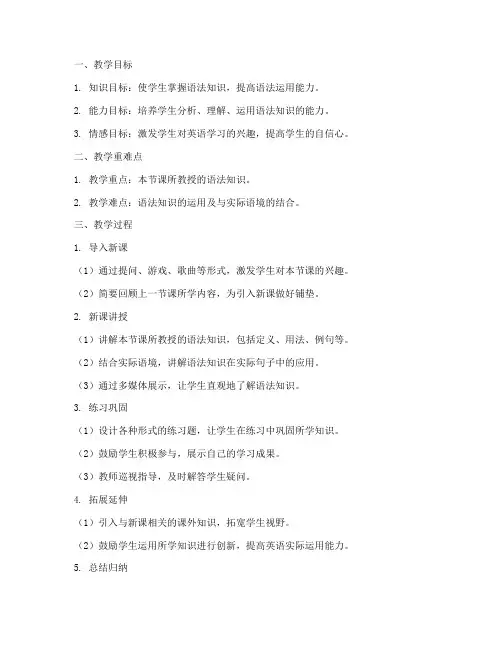
一、教学目标1. 知识目标:使学生掌握语法知识,提高语法运用能力。
2. 能力目标:培养学生分析、理解、运用语法知识的能力。
3. 情感目标:激发学生对英语学习的兴趣,提高学生的自信心。
二、教学重难点1. 教学重点:本节课所教授的语法知识。
2. 教学难点:语法知识的运用及与实际语境的结合。
三、教学过程1. 导入新课(1)通过提问、游戏、歌曲等形式,激发学生对本节课的兴趣。
(2)简要回顾上一节课所学内容,为引入新课做好铺垫。
2. 新课讲授(1)讲解本节课所教授的语法知识,包括定义、用法、例句等。
(2)结合实际语境,讲解语法知识在实际句子中的应用。
(3)通过多媒体展示,让学生直观地了解语法知识。
3. 练习巩固(1)设计各种形式的练习题,让学生在练习中巩固所学知识。
(2)鼓励学生积极参与,展示自己的学习成果。
(3)教师巡视指导,及时解答学生疑问。
4. 拓展延伸(1)引入与新课相关的课外知识,拓宽学生视野。
(2)鼓励学生运用所学知识进行创新,提高英语实际运用能力。
5. 总结归纳(1)对本节课所学内容进行总结,让学生回顾所学知识。
(2)强调语法知识的重要性,鼓励学生在日常生活中多加运用。
四、教学评价1. 课堂表现:观察学生在课堂上的学习态度、参与程度等。
2. 作业完成情况:检查学生对课堂所学知识的掌握程度。
3. 课堂练习:评估学生在课堂练习中的表现。
五、教学反思1. 教学过程中,关注学生的学习需求,调整教学策略。
2. 鼓励学生积极参与,提高课堂氛围。
3. 及时反馈,关注学生进步,激发学习兴趣。
以下为具体教案示例:教案名称:高中英语语法《现在进行时》一、教学目标1. 知识目标:使学生掌握现在进行时的构成、用法及意义。
2. 能力目标:培养学生运用现在进行时描述正在发生的动作的能力。
3. 情感目标:激发学生对英语学习的兴趣,提高学生的自信心。
二、教学重难点1. 教学重点:现在进行时的构成、用法及意义。
2. 教学难点:现在进行时在句子中的运用及与一般现在时的区别。
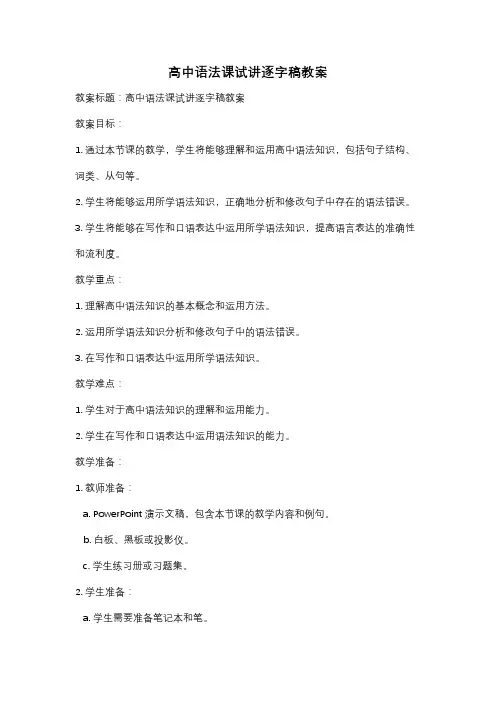
高中语法课试讲逐字稿教案教案标题:高中语法课试讲逐字稿教案教案目标:1. 通过本节课的教学,学生将能够理解和运用高中语法知识,包括句子结构、词类、从句等。
2. 学生将能够运用所学语法知识,正确地分析和修改句子中存在的语法错误。
3. 学生将能够在写作和口语表达中运用所学语法知识,提高语言表达的准确性和流利度。
教学重点:1. 理解高中语法知识的基本概念和运用方法。
2. 运用所学语法知识分析和修改句子中的语法错误。
3. 在写作和口语表达中运用所学语法知识。
教学难点:1. 学生对于高中语法知识的理解和运用能力。
2. 学生在写作和口语表达中运用语法知识的能力。
教学准备:1. 教师准备:a. PowerPoint演示文稿,包含本节课的教学内容和例句。
b. 白板、黑板或投影仪。
c. 学生练习册或习题集。
2. 学生准备:a. 学生需要准备笔记本和笔。
b. 学生需要预习本节课的教学内容。
教学过程:Step 1: 导入(5分钟)教师通过提问或展示一段包含多个语法错误的句子引起学生的兴趣,激发学生对于语法知识的学习欲望。
教师示范:教师:大家好!今天我们将学习高中语法课的内容。
首先,请看下面这个句子:“我昨天去商店买了一个苹果,然后我回家吃了。
”请问这个句子有什么问题?学生回答:句子中有重复使用了两次的“我”。
教师:非常好!这个句子中使用了两次的“我”是一个语法错误。
那么,我们应该如何修改这个句子呢?学生回答:可以将其中一个“我”改为其他代词,比如“他”。
教师:非常好!你们已经找出了这个句子的语法错误,并提出了正确的修改方法。
那么,我们接下来就来学习一些高中语法知识,帮助我们更好地理解和运用语法。
Step 2: 语法知识讲解(15分钟)教师通过PPT演示文稿或黑板白板讲解高中语法知识的基本概念和运用方法,包括句子结构、词类、从句等。
教师可以结合例句和图表进行讲解,以便学生更好地理解。
教师示范:教师:现在,请大家打开课本第10页。
课程名称:高中英语语法授课对象:高中一年级学生课时安排: 1课时教学目标:1. 知识目标:掌握所讲语法点的概念、用法及典型例句。
2. 能力目标:提高学生运用所学语法知识进行交际的能力。
3. 情感目标:激发学生学习英语的兴趣,培养学生良好的学习习惯。
教学重点:本节课所讲语法点的概念和用法。
教学难点:本节课所讲语法点的灵活运用。
教学准备:1. 教师准备:PPT课件、语法练习题、实物或图片等教学辅助材料。
2. 学生准备:预习所讲语法点,准备与语法点相关的例句。
教学过程:一、导入新课(5分钟)1. 利用图片、视频或实物导入,激发学生学习兴趣。
2. 提问:同学们,你们知道今天我们要学习什么语法点吗?简单介绍本节课所讲语法点。
二、讲解新课(25分钟)1. 讲解语法点的概念,结合例句进行分析。
2. 展示PPT课件,详细讲解语法点的用法,包括时态、语态、非谓语动词等。
3. 结合实物或图片,让学生进行实际操作,加深对语法点的理解。
三、课堂练习(15分钟)1. 分组练习,让学生运用所学语法点进行交际。
2. 教师巡视指导,纠正学生的错误。
四、课堂小结(5分钟)1. 回顾本节课所讲语法点,强调重点和难点。
2. 布置课后作业,巩固所学知识。
五、课后作业1. 完成课后练习题,巩固所学语法点。
2. 搜集与所学语法点相关的例句,进行积累。
教学反思:1. 本节课的教学效果如何?2. 学生对所讲语法点的掌握程度如何?3. 教学过程中有哪些不足之处?4. 如何改进教学方法,提高教学效果?板书设计:高中英语语法试讲教案模板课程名称:高中英语语法授课对象:高中一年级学生课时安排: 1课时教学目标:1. 知识目标:掌握所讲语法点的概念、用法及典型例句。
2. 能力目标:提高学生运用所学语法知识进行交际的能力。
3. 情感目标:激发学生学习英语的兴趣,培养学生良好的学习习惯。
教学重点:本节课所讲语法点的概念和用法。
教学难点:本节课所讲语法点的灵活运用。
高中英语试讲教案教案背景该教案适用于高中英语语法教学,主要教授条件状语从句的用法和结构。
学生已经学过基本的英语语法知识,并且有一定的英语基础。
课时约为45-50分钟。
教学目标通过本节课的学习,学生应当能够:1.理解条件状语从句的用法和结构;2.掌握条件状语从句中的虚拟语气;3.运用条件状语从句正确地表达自己的想法。
教学准备1.一张黑板或白板;2.教师准备好课件和教材;3.学生需要带上自己的学习笔记。
教学过程一、导入(5分钟)教师引入本课内容,简要介绍本节课教学目标以及所需的知识点。
二、理论讲解(20分钟)教师通过PPT和黑板讲解以下内容:1.条件状语从句的定义和基本结构;2.如何使用条件状语从句表达假设或条件;3.条件状语从句中的虚拟语气概念;4.条件状语从句中虚拟语气的几种类型,以及每种类型的用法和特点。
三、教学实践(20分钟)1.教师通过PPT上的例题,帮助学生理解条件状语从句的基本结构和常见用法;2.教师要求学生根据自己的笔记,结合PPT上的例题翻译出虚拟语气的用法;3.学生根据题目,写出相关条件状语从句的形式并制造出语境练习。
四、巩固练习(5分钟)教师设计一道巩固练习题目,要求学生根据语境,使用条件状语从句以及虚拟语气进行写作。
五、作业布置(5分钟)布置与本节课相关的作业:解答或翻译指导书上的练习题目,并评选出最优秀的三位同学答案进行展示。
教学总结以上内容是本节课的教学内容。
通过本节课的学习,学生应该掌握条件状语从句的基本用法和结构,并且能够理解虚拟语气的概念。
通过实践练习,学生能够更好地掌握语法知识,提高英语语言运用的能力。
课程名称:高中英语(例如:英语语法、阅读理解、写作等)授课年级:高中年级授课时间: 45分钟教学目标:1. 知识目标:学生能够掌握本节课的核心知识点。
2. 能力目标:学生能够运用所学知识进行实际操作或解决问题。
3. 情感目标:激发学生学习英语的兴趣,培养良好的学习习惯。
教学重点:本节课的核心知识点。
教学难点:学生在理解和运用本节课知识点时可能遇到的困难。
教学准备:1. 教学课件或黑板。
2. 相关教学材料,如教材、练习册等。
3. 多媒体设备,如电脑、投影仪等。
教学过程:一、导入(5分钟)1. 通过图片、视频、歌曲等方式,激发学生的学习兴趣。
2. 提出与本节课相关的问题,引导学生思考。
二、新课讲解(20分钟)1. 导入新课:通过复习上一节课的知识,自然过渡到本节课的内容。
2. 讲解知识点:- 系统讲解本节课的核心知识点,结合实例进行说明。
- 使用多种教学方法,如讲解、讨论、演示等,提高学生的参与度。
- 强调重点和难点,帮助学生理解和掌握。
3. 互动环节:- 提问学生,检查他们对知识点的理解程度。
- 组织小组讨论,让学生运用所学知识解决问题。
三、巩固练习(15分钟)1. 练习题:设计与本节课知识点相关的练习题,让学生在练习中巩固所学知识。
2. 讲解练习:对学生的练习情况进行讲解,纠正错误,加深印象。
四、总结与作业布置(5分钟)1. 总结:总结本节课的重点内容,强调学生的收获。
2. 作业布置:布置与本节课知识点相关的作业,巩固学生的知识。
五、课堂反思1. 教师反思:对本节课的教学效果进行反思,总结经验教训。
2. 学生反思:鼓励学生反思自己的学习过程,找出不足,制定改进措施。
教学评价:1. 学生对知识点的掌握程度。
2. 学生在课堂上的参与度。
3. 学生对英语学习的兴趣和态度。
教学延伸:1. 结合教材内容,设计拓展活动,提高学生的英语应用能力。
2. 鼓励学生参加英语角、英语演讲等活动,提高英语口语水平。
备注:1. 教师应根据学生的实际情况调整教学内容和教学方法。
一、教学目标1. 知识与技能目标:- 学生能够掌握所讲语法点的概念、用法及例句。
- 学生能够运用所学语法点进行简单的句子构造和对话交流。
2. 过程与方法目标:- 通过小组讨论、角色扮演等活动,提高学生的语法运用能力和语言表达能力。
- 培养学生自主学习、合作探究的学习习惯。
3. 情感态度与价值观目标:- 激发学生学习英语的兴趣,树立学习英语的自信心。
- 培养学生良好的学习态度和合作精神。
二、教学重点与难点1. 教学重点:- 所讲语法点的概念、用法及例句。
2. 教学难点:- 所讲语法点在实际语境中的运用。
三、教学过程1. 导入新课(5分钟):- 通过复习上一节课的内容,导入本节课的语法点。
- 设计一个与语法点相关的情景,激发学生的学习兴趣。
2. 新课讲解(20分钟):- 利用PPT展示语法点的概念、用法及例句,结合实际语境进行讲解。
- 邀请学生参与课堂互动,回答问题或进行句子构造。
3. 小组活动(15分钟):- 将学生分成小组,进行以下活动:- 小组讨论:运用所讲语法点进行句子构造或对话交流。
- 角色扮演:模拟实际情景,运用所讲语法点进行对话。
4. 课堂练习(10分钟):- 进行课堂练习,巩固所学语法点。
- 学生独立完成练习,教师巡视指导。
5. 总结与反思(5分钟):- 学生总结本节课所学内容,教师进行点评和总结。
- 鼓励学生提出疑问,共同探讨。
四、教学评价1. 课堂表现:- 观察学生的参与程度、回答问题的准确性、小组活动的表现等。
2. 课后作业:- 布置与所讲语法点相关的课后作业,巩固所学知识。
五、教学资源1. PPT课件:展示语法点的概念、用法及例句。
2. 课堂练习题:巩固所学语法点。
3. 教学视频:展示语法点的实际运用。
六、教学反思1. 教师在课堂上要关注学生的学习状态,及时调整教学策略。
2. 鼓励学生积极参与课堂互动,提高学生的语法运用能力。
3. 关注学生的个体差异,因材施教。
七、板书设计语法点: [所讲语法点的名称]- 概念:- 用法:- 例句:- 实际运用:八、教学时间1. 导入新课:5分钟2. 新课讲解:20分钟3. 小组活动:15分钟4. 课堂练习:10分钟5. 总结与反思:5分钟九、注意事项1. 教师在讲解语法点时,要注意语言简洁明了,避免使用过于复杂的句子。
课程目标:1. 让学生掌握名词性从句的构成和用法。
2. 提高学生分析句子结构的能力,培养良好的语法意识。
3. 增强学生的语言表达能力和实际运用能力。
教学重点:1. 名词性从句的种类和构成。
2. 名词性从句在句子中的作用和用法。
教学难点:1. 名词性从句与主句之间的逻辑关系。
2. 名词性从句的连接词选择。
教学准备:1. 多媒体课件2. 名词性从句练习题3. 课堂互动环节所需的材料教学过程:一、导入1. 通过展示一些含有名词性从句的例句,引导学生回顾名词性从句的概念。
2. 提问:什么是名词性从句?它在句子中有什么作用?二、新课讲解1. 讲解名词性从句的种类:a. 宾语从句b. 主语从句c. 状语从句d. 同位语从句2. 分析每种名词性从句的构成和用法:a. 宾语从句:由从属连词引导,在句子中作宾语。
b. 主语从句:由从属连词引导,在句子中作主语。
c. 状语从句:由从属连词引导,在句子中作状语。
d. 同位语从句:由从属连词引导,对名词进行补充说明。
3. 结合例句讲解名词性从句在句子中的作用和用法。
三、课堂练习1. 学生完成名词性从句的练习题,巩固所学知识。
2. 教师选取部分练习题进行讲解,帮助学生理解和掌握。
四、课堂互动1. 教师设置情境,让学生用名词性从句进行造句。
2. 学生展示自己的句子,教师进行点评和指导。
五、总结1. 总结名词性从句的种类、构成和用法。
2. 强调名词性从句在句子中的作用和重要性。
六、作业布置1. 完成课后练习题,巩固所学知识。
2. 收集生活中常见的名词性从句例句,进行整理和总结。
教学反思:本节课通过讲解、练习、互动等多种形式,帮助学生掌握了名词性从句的构成和用法。
在教学过程中,教师应注意以下几点:1. 注重基础知识的讲解,让学生对名词性从句有清晰的认识。
2. 结合例句进行讲解,让学生更好地理解名词性从句在句子中的作用。
3. 鼓励学生积极参与课堂互动,提高他们的语言表达能力和实际运用能力。
课程名称:高一英语语法课时: 1课时教学目标:1. 知识目标:使学生掌握特定的语法点,如时态、语态、非谓语动词等。
2. 能力目标:培养学生运用所学语法知识进行听、说、读、写的能力。
3. 情感目标:激发学生学习英语的兴趣,提高学生的英语学习自信心。
教学重点:- 语法点的具体内容- 语法点的实际运用教学难点:- 语法点的理解与运用- 语法点的错误纠正与巩固教学准备:- 多媒体课件- 练习题- 实物教具(如有需要)教学过程:一、导入(5分钟)1. 通过提问或游戏活动,引入本节课的语法主题。
2. 例如,可以提问学生:“Do you know what tense is? Can you give me an example?”(你们知道什么是时态吗?能给我举一个例子吗?)二、新课讲解(20分钟)1. 详细讲解语法点的定义、用法和例句。
- 使用PPT展示语法点的基本知识,如时态的构成、语态的变化等。
- 结合实际例句,帮助学生理解语法点的运用。
- 通过对比不同语法点的用法,让学生更容易区分和记忆。
2. 互动环节:邀请学生回答问题,巩固所学知识。
- 例如,提问:“What is the difference between the simple present tense and the present continuous tense?”(简单现在时和现在进行时有什么区别?)三、练习巩固(15分钟)1. 分组练习:将学生分成小组,进行语法点相关的练习。
- 例如,可以让学生完成填空题、选择题或改错题。
2. 个别辅导:对学习有困难的学生进行个别辅导,确保他们能够理解和掌握语法点。
四、总结与作业布置(5分钟)1. 总结本节课所学语法点,强调重点和难点。
2. 布置课后作业:- 完成一定数量的语法练习题。
- 用所学语法点写一篇短文。
五、课堂小结(5分钟)1. 回顾本节课的教学内容,检查学生的学习效果。
2. 鼓励学生课后复习,巩固所学知识。
语法试讲教案Grade level: First grade of High schoolLesson type: ReadingDuration: 45minTeaching objectives1) Help students to learn the usage of ….2) Help students to grasp the sentence pattern of…..Teaching aidsMultimedia devices, blackboardTeaching important and difficult points1) the sentence pattern of…2) some special cases3) enable students to use … in real lifeTeaching proceduresStep 1 Lead-in (5min)Show some pictures to the students and ask them to describe the picture. 引导学生运用语法项目Step 2 Explanation (18min)Explain the usage of …. Present several examples of the grammar item.Step 4 Practice (15min)Ask the students to do the exercises.Step 3 Summary(4min)Invite students to summarize the usage of … Make some supplements and stress the important points.Step 5 Homework (3min)Ask students to finish related exercise on the textbook. Ask the students to write a passage about ….(You have all done a really good job today. I believe you already have a good knowledge of /master the knowledge of….. For homework, you are required tocomplete exercises on page 201 and to write a passage about ….[I’d rather you search more information about… and some of you will be invited to share y our findings with us in the next class.] Clear? Ok. See you next class.)写作试讲教案Grade level: First grade of High schoolLesson type: ReadingDuration: 45minTeaching objectives1) enable students master the procedure of writing this kind of composition2) improve students’ writing skills3) help students to get more knowledge of …Teaching aidsMultimedia devices, blackboardTeaching important &difficult points1) Help students to express their ideas in proper English2) Help students to learn the structure in English writingTeaching proceduresStep 1 Warming-up (5min)Show some pictures of … to the students and ask what do they know about … Then lead the students to the topic of writing.(Good morning, boys & girls. How are you doing? Fine? Good. Now let’s start our new lesson. Here I have some pictures for you. Do you know what’s in the picture?) Step 2 Pre-writing(10min)Activity 1: brainstorming. Provide Ss some questions about the topic and ask them to discuss the questions in group and write down every idea that comes to their mind. After discussion, invite representatives of each group to present their ideas to the whole class.Activity 2: planning. Encourage Ss to work on their own to repot ideas that they think are valuable and think about how to organize their ideas.Step 3 While-writing (20min)Ask the students to write down their own articles.Step 4 Post-writing (7min)Ss will work in group and read each other’s composition. They should choose the best composition of the group and read it in front of the class.Step 5 Writing assessment (2min)Ask Ss: What’s you most difficult thing during the whole process?(difficult to organize the ideas in a logical way; you feel brainstorm is difficult, difficult to provide persuasive reasons to support the idea)Step 6 Homework (1min)1) Here are some handouts I prepared for you. Read it after class, I believe you can find answers towards your questions.2) Improve your composition according to the handout.听力课试讲教案Grade level: First grade of high schoolLesson type: ListeningDuration: 45 minTeaching objectives1) Enable students to master different listening skills2) Help students to learn more about …..Teaching aids:Multimedia devices; blackboardTeaching important and difficult points1) Help students to understand the listening material2) Encourage students to apply listening skills when listening to the material Teaching proceduresStep 1 Warming-up (2min)Show some pictures to the students and have a free talk with the students. Step 2 Pre-listening (5min)Organize the students to have a brief discussion about the topic. Invite some students to share their ideas with the class. Predict the main idea of the passage. After that,present new words and expressions to the students.Step 3 While-listening (25min)1) Listen for main ideaAsk Ss to listen to the passage but do not look at the questions, ask them to get the main idea of the passage. Invite students to share their ideas.2) Listen for answers to the exercises/detailed informationAsk Ss to listen to the passage again. This time ask them to try their best to get answers to the questions. After listening, check whether Ss get the correct answer, and ask why.3) Play the tape again, focus on the part where they did not get the right information. Do you have any questions?Step 4 Post-listening (10min)Show them the listening text and ask them to read it aloud together.Step 5 Summary (2min)In this period, we mainly focus on the listening ability. It’s very important. If your listening is poor, you’d better practice more. The more you listen to English, the better your listening is. Remember: Practice makes perfect.Step 6 Homework (1min)1) Read the listening texts again and try to retell the passage in your own words2) Search more information about ….口语课试讲教案Grade level: First grade of high schoolLesson type: SpeakingDuration: 45 minTeaching objectives1) Students will be able to use some important words and expressions2) Students will be able to express their ideas or thoughts clearly.Teaching aidsMultimedia devices; blackboardTeaching important and difficult points1) Help Ss to master the expressions of giving advice:2) Talk about … by using …Teaching proceduresStep 1 Warming-upShow Ss some pictures of … and ask students to descri be what they are doing. Step 2 Lead-inPlay the tape and ask Ss to listen to the dialogue. Ask Ss to predict what we will learn today. Step 3 Provide key sentence patterns & expressionsProvide Ss useful sentence patterns and expressions to express …..Step 4 Role-play/ DiscussionGive the Ss a situation, and ask the Ss to work in pairs and make up a conversation. Ask the Ss to discuss the topic with their partners.After that, invite Ss to present their ideas in front of the class.Step 5 SummaryIn this p eriod, we mainly focus on how to…. It’s very important. You should know how to … inreal life after this period. You should memorize the useful expressions we learned today. I hope you can practice more after class. Remember: practice makes perfect.Step 6 Homework1) Collect more expressions and sentence patterns that can be used to express …..2) Find a partner to practice how to … in different situations.词汇课试讲教案Grade level: First grade of high schoolLesson type: VocabularyDuration: 45 minTeaching objectives1) Enable students to know the meaning of new words and grasp the usages of such important new words2) Enable Ss to use such new words in their own writing or speakingTeaching aidsMultimedia devices; blackboardTeaching important and difficult points1) Explain the meaning and usage of the words to the students2) Enable Ss to use the new words when they express themselvesTeaching proceduresStep 1 Lead-inRevision. Last period, we have finished the reading of the passage. Now we will learn the new words in the passage. Let’s look at the underlined/italic/bold words. Step 2 GuessAsk Ss to guess the meaning of the words in the context. Or give students some examples and ask Ss to guess the meaning of the words.Step 3 ExplanationExplain the meaning of the words to the Ss. After explanation, present the usage of the words to the students and provide examples to help them understand how to use them. Step 4 PracticeAsk the students to make sentences with new words by themselves. Invite Ss to share their sentences with the whole class.Step 5 SummaryThis, period, we have learnt several new words:... we have learnt the usage of these new words. I hope you will memorize these words, as well as the usage of these words. I suggest you use the new words as often as possible. In this way, you will know how to use the words, instead of only knowing the meaning of the words. Step 6 Homework1) Look up these new words in the dictionary, and get more meanings and usage of them in the dictionary.2) Finish Exercise 2 on page 11.require.async(['wkcommon:widget/ui/lib/sio/sio.js'], function(sio) { var url = 'https:///cpro/ui/c.js'; sio.callByBrowser( url, function (){ BAIDU_CLB_fillSlotAsync('u2845605','cpro_u2845605'); } ); });New words: New phrases: Step5: SummarySs summarize what we have learnt and key points. Make an assessment on each group. Ste p6: HomeworkWrite a diary with simple past tense. Blackboard design: Title:Questions: New words :文章线索(便于复述)口语课教学过程:看图,问答练习,重点句呈现讲解,小组练习,展示成果 Teaching Objectives:1. Be able to master the following words and sentence pattern. And learn the expression of giving advice .2. Be able to talk about one‟s health problems and give advice fluently3. Improve the cooperative spirit and care more about yourself and your family members‟ h ealth. Teaching Aids: Pictures, a tape recorder and ppt. The teaching Focus:1. Master the following words and sentence pattern.2. Master the expressions of giving advi ce The Teaching Difficulties:1. Students may find it difficult to remember all the target new words in the class;2. Students may find it difficult to give appropriate advice to the certain disease because of t heir limited life experience. Teaching procedure: Step1:Warming upGreet Ss by asking them: How are you today? Then I‟ll tell Ss that I‟m not feeling well today (Write the sentence on the blackboard and guide Ss to read it.) and get Ss to guess the reas on freely. If Ss can‟t get the answer, I‟ll tell them that I didn‟t have a good sleep last night. S o I have a headache. (I say this by doing a gesture)Step2: Presentation of words and sentence patterns1. Let one student imitate he has a kind of disease and ask the class guess what …s the matte r with him. Use the following sentence:”what‟s the matter with him?”“I have a stomache.”2. Show Ss pictures of diseases.( Write the words on the black board.) Step3: Pair workAsk Ss to work in pairs and talk about health problems by using the bandage given and usin g the target language: What‟s the matter? I‟m not feeling well. I have a … Step4: Presentatio n of expressions of giving adviceTell Ss that I have a cold/cough, ask them: What should I do? Ss may give different answers, collect their answers and help them to use: You should/shouldn‟t d o… During this activity, s ome phrases will be learned: ... Step5: Role play1.Show the sample dialogue and ask Ss to complete it according to the picture orally.Ask Students to make a four -people group, one of them is a doctor, the other three are pat ients. Ask the Ss to role play a dialogue . A: What‟s the matter with you?B: I‟m not feeling well. I have a _______. A: When did it start? B: About______ ago.A: Oh, that‟s too bad. / I‟m sorry to hear that. You should/shouldn‟t ________ and you shoul d/shouldn‟t ________... B: Yes, I think so.A: _________________.B: Thank you, doctor. Step5: SummarySs summarize what we have learnt. Make an assessment on each group. Step6: Homework Try to make a story according to the dialogue. Blackboard design: Title:New words and phrases : Sentence pattern :语法课:复习导入,查找标记相关句子,总结规律,练习(造句,讨论) Teaching objectives: 1.Enable the Ss to know the uses of adjectives ending in -ing / -ed and the differences betw een them.2. Master the following words and sentence pattern.Main word and Expression: amazed, amazing, interested, interesting, bored, boring.Main structure: The classroom was amazing. I was completely amazed by the classroom. Tea ching aids: Pictures, a tape recorder and ppt. Teaching important points:Get the Ss to know the differences between the adjectives ending in -ing and -ed and learn the uses of them in the sentences. Teaching difficult points:Understand the differences between the adjectives ending in –ing and –ed and apply them i n the sentences .Teaching procedure: Step 1 Lead inGreet the students and say some words which includes the language points. Then tell them what we are going to learn is the differences and uses of the adjectives ending in –ing and –ed . Ask students to think about the question below and try to figure out the right answer. ---Can you make a distinguish between the two sentences? I am bored. I am boring .Step 2 discovering and explaining.Ask the students to read the text and try to find out the sentences which have the adjectives ending in -ING and –ED. Try to find the differences and understand the meaning of these a djectives. Step 3 Group workLet students work in groups and have a discussion. Try to find the differences of these adjec tives and explain the meaning of these sentences according to the context. Step 4 Conclusio n and exerciseInvite students to make a report about their group discussion and teacher will make a concl usion according to their report. Find the grammar rules:1: The –ing form describes the people or things that cause the feeling;(令人…)2: The –ed form tells us how people feel.(感到…)Give some examples to show what they have learned and ask students to do exercise and c heck the answers. Fill in the blank with the correct forms of words. It is a ____ (bore)party and I feel__(bore). Step 5 Homework1. Find out more adjectives ending in -ing and -ed and sentences.e the -ED and -ING form of the words “bore”“interest”“amaze” and “embarrass” to ma ke sentences.Blackboard design: Title:Teaching procedures:Step 1: GreetingsT: Good morning, everyone.S: Good morning, Mr Dai.Step 2: Lead-inT: My lovely Ss, please look at the screen. What is the topic of our class?Ss: Unforgettable experiences.T:Yes. Please use one word to describe it, such as “happy”.S1:…S2:………T: perfect, all of you are knowledgeable.(Ask Ss one by one, and choose some words write down on the blackboard.)T:Okay. You see, all of you used many different words to describe, like…(write down on the blackboard.)Step 3: Activities1. Acitivity1: Telling story(Make a short conclusion)T: Different people have different understanding of our topic. Now, look at the screen, I’ll show you some aspects of our topic. First, unforgettable experience sometimes means something leaves deep impression on you. Such as……(the words of Ss’) It also can means events, some are good, and some are bad. (Olympic Games, natural disasters, etc.) Or, it may be means something very meaningful. And, it also can means your unforgettable trip; you went to some famous places. For example, went to zoos. Yes, I have gone to Linyi Wild Zoos last week. I saw many different ki nds of animals there. It’s so enjoyable and meaningful. You can see the pictures…. Do you want to know more information about my “Zoo’s trip”?Ss: Yes.T: OK. Let’s see it together.(Present the route of my tour on the blackboard or ppt, use First—Next—Then—Finally to describe.)T: Look at my route on the Blackboard:(My own experience:It was a fun day. I went to Linyi Wild Zoos with my friends. First, we took on the bus at bus station. Because we would see many dangerous and ferocious animals such as lions, tigers, wolves , etc. After about half an hour, we backed to the station. Next, we walked to see some gentle animals like pandas, different kinds of birds, monkeys, swans and so on. Then, we went to see the animals’ shows. They are so lovely, interesting and smart. Finally, we went to the restaurant to have dinner. Although all of us were very tired, we were happy and enjoyable.)T: How do you think of my experience?Ss:…T:But I believe yours must be better than mine.Now, working in pairs, share your own unforgettable experiences with your partner.T:I can see all of you are eager to tell your stories. ..., who do you think has the most interesting story in our class?S1:**.T:OK. Thank you.Jack, please share your unforgettable experience.S2:…T:You say that… Whose story are you interested in , you can call his or her name.……T. All of you did a very good job. And I am very proud of you. Give you a big hand. If you want to know more, you can communicate with your classmates after class.2. Activity2: Making storyT: Next, let’s play a mini-game.Looking at the blackboard, there are two faces, one is… the other is…I will ask two students to write down some relevant words or phrases.……T: Now, I have several envelopes in my hands. Do you want to know what is it in it?Ss:Yes.T:Okay. I will divide you into several groups. Each group chose one envelope. And you will know the secret in it.(Making the short dialogue according to the paper in envelope.After they finished, ask one student of each group to stand on the stage to tell their story.)Step4: SummaryT: We have learned many useful words, phrases, and sentences to describe our own experience. In next days, you can use them to talk about things, people and events in your own daily life.Step5: HomeworkT: After class, each group prepare a play according your story. At next class, you will have a role play. Are you clear?高中英语教师资格证面试教案模板二Teaching Objectives(教学目标)1. Language Objectives (知识目标)2. Ability Objectives(能力目标)(1)Enable students to …(2)…3. Moral Objectives (情感、态度及价值观目标)(1) Help students to learn that…(2) …注:1.Teaching Objectives的三个目标可以根据授课内容不同加以取舍。